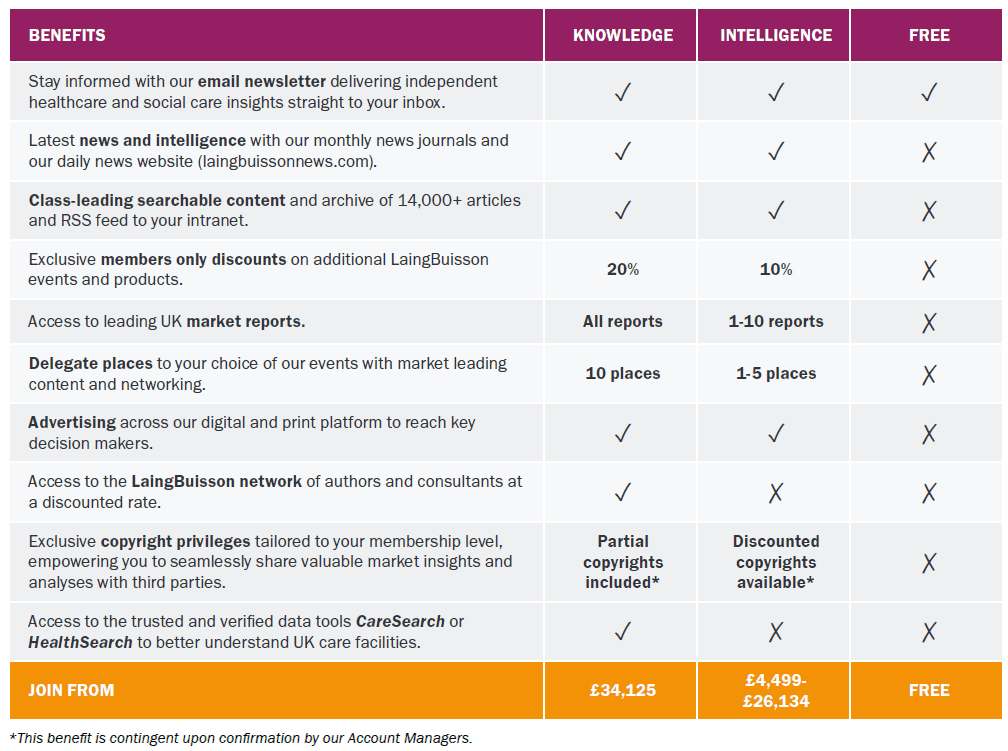Private healthcare market valued at record £12.4bn as long NHS waiting lists continue to fuel demand
LaingBuisson has published the 9th edition of their Private Acute Healthcare UK Market Report.
Highlights from LaingBuisson’s Private Acute UK Market Report (ninth edition):
- Overall market value for the private acute healthcare sector is estimated at £12.4 billion – with private acute hospitals accounting for approximately £6.7 billion.
- The private clinics and privately practising doctors market segment is valued at £4.9 billion and NHS revenue from private patients is valued at £700 million.
- The five largest operators account for 75% of all private hospital revenue
- Private medical cover has boomed – with hospital revenue from this payor source experiencing year-on-year growth of 17.8% (2022 to 2023)
- Over the last 20 years, NHS funding has increased from a 10% share to an estimated post-Covid share of 31% (2003-2023)
- Ophthalmology is driving a large volume of all NHS-funded activity into the independent sector – with ophthalmic clinic chains growing rapidly. The four largest providers have opened 64 clinics between them in the last three years – compared to 57 between 2011 and 2020.
Record demand is driving continued growth in the private healthcare sector as increasing numbers of patients use private medical insurance to fund their treatment, according to research published today by LaingBuisson.
LaingBuisson’s latest annual Private Acute Healthcare Report values the total UK market at £12.4 billion in 2023.
Private hospitals remain the largest section of the market at £6.8 billion (up nearly £800 million since the previous year) – 75% of which is generated by the five biggest hospital groups. However, independent clinics and privately practising doctors account for a significant proportion of revenue at £4.9 billion. The remaining market value is made up of NHS Private Patient Units (NHS PPUs), which had estimated total revenues of £700 million.
Patients have continued to turn to private healthcare providers against the backdrop of long NHS waits. The significant increase in revenue generated by private health insurance in 2023 remains in line with the positive trend in this segment seen since the pandemic. Despite a softening of self-funder demand at hospital level, there has been a marginal increase in revenues. Self-pay volumes have held up more strongly in clinics than in private hospitals, likely reflecting the more accessible lower price points for services such as outpatient diagnostic tests. After a slow recovery in the immediate aftermath of the pandemic, NHS funded activity in private hospitals has also rebounded. NHS revenue accounted for 31% of private hospital revenue in 2023 compared to just 10% two decades ago.
Unsurprisingly, the two specialties with the longest NHS waits – ophthalmology and orthopaedics – continue to see the biggest boom in independent sector activity. More NHS-funded cataract surgery now take place in the independent sector than in the NHS. Independent sector providers have responded to increased demand with rapid expansion. Since 2020, leading providers Newmedica, Spamedica, CHEC and Optegra have all opening additional clinics. In the last three years, these providers have opened a combined total of 64 new sites compared to 57 in the nine years between 2011 and 2020.
Report author, Tim Read said:
“LaingBuisson’s analysis suggests that the private acute healthcare market is continuing to benefit from the challenges impacting the NHS. If last year’s reported growth was dampened by broader economic factors, today’s figures show a market that has grown substantially in real terms.
“Hospital providers are benefitting from the continuing boom in private health insurance and this has off-set a slight softening in demand from those paying out of their own pocket for care. For those providers that are more focused on providing additional capacity to the NHS there remains little sign that there is a lessening of need of independent sector support and revenue from this segment has remained robust.
“Continued growth in corporate employers introducing health insurance for staff is helping drive usage of independent sector services – potentially from individuals that have never previously experienced care outside of the NHS – and helps remove some of the traditional price point barriers that may have stopped people paying for their own care in the past.
“It remains to be seen how this begins to change people’s relationship with public-pay healthcare, although public surveys have suggested increasing willingness to pay for services that allow timely access to diagnosis, alongside those providing treatment. This hints at the extent to which dissatisfaction with the ability to access public-pay entitlements is now playing out in turning individuals from patients into consumers who are making conscious choice decisions over the healthcare they receive.
“However, many people are unable to pay for their own care, and independent providers should be considering the role they play in the wider healthcare ecosystem. The Labour government has indicated it will take a pragmatic approach to the independent sector – seeing a role in helping resolve the NHS elective backlog – but are likely to become sensitive to accusations that those who can afford it are using private healthcare to access diagnostic outcomes that allow them to jump ahead of those who wait for access under NHS timelines. Whatever comes next, it seems clear that the independent sector is going to be an increasingly key part of the conversation.”







